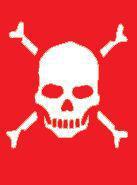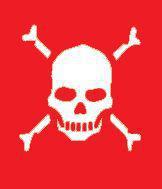SAS Urban Survival Handbook (74 page)
Read SAS Urban Survival Handbook Online
Authors: John Wiseman
Tags: #Health & Fitness, #Reference, #Survival, #Fiction, #Safety, #Self-Help, #Personal & Practical Guides, #General, #Survival Skills

WARNING
Pain in the chest or shooting down the arms can mean your heart is under too much strain. It doesn’t necessarily mean that you’re having a heart attack, but you should still get yourself checked out medically just for peace of mind.
WOMEN AND SPORT
Specific differences that may affect women’s performance in sport, or the risks of particular sports, include:
- ■
Smaller hearts and lungs than men - ■
Less muscle bulk and strength than men - ■
Better fat-burning mechanism than men (useful in endurance sports) - ■
Higher fat percentage (25% on average) - ■
Lower centre of gravity than men - ■
Smaller stature (useful in some sports – riding, for example) - ■
Wide pelvis alters angle of femur – can lead to knee problems in running - ■
Breast pain and jogger’s nipple can be caused by running - ■
Joint looseness (useful in some sports – gymnastics, for example) - ■
Reproductive organs well protected - ■
Menstrual cycle can be affected by strenuous exercise - ■
Pregnancy hormones loosen ligments - ■
The contraceptive pill increases risk of cardiovascular strain
REMEMBER
′NO PAIN, NO GAIN′ IS WAY OUT OF DATE. Yes, stretching and strenuous exercise can be uncomfortable, but there’s a difference between a working bum and the pain of a torn muscle! Be sensitive to the difference! If the pain is sudden, unusual or excessive, slacken off, STOP and find out what it is. The natural ‘high’ – the endorphins and adrenalin stimulated by exercise, the increased blood flow and oxygen levels – can blind you to your body’s distress signals. DO NOT use painkillers, stropping, sprays and creams to mask injury. Pain is your body’s early warning system. LISTEN TO IT!
CHILDREN AND SPORT
Medical advice and expert tuition should be sought to determine the effect of the stresses and strains of different sports on growing bones and muscles. Exercise for young children should mainly involve learning balance, coordination and spatial awareness. As the young person reaches puberty, hormone production and growth may be affected by strenuous exercise. NEVER force a child to over-use muscles and joints – by lifting weights, for example. If a particular interest is shown in any type of sport, seek specialist advice to make it SAFE.
TYPES OF INJURY
Some of the most common injuries associated with sports, together with basic preventative measures and first aid, are dealt with here. ALL coaches should have training in the recognition and first-aid treatment of injuries associated with their sports. ALL sports centres, sports grounds and gyms should encourage their members to learn the basics, too.
Muscles
Tears, strains, sprains
and
pulls
of the elastic fibres that form muscle are very common. Many of these injuries can be prevented by keeping the muscles in good condition, and by warming them up before exertion EVERY TIME. The quadriceps at the front of the thigh and hamstrings at the back of the leg are particularly at risk from sudden movement, imbalance of power between the two sets of muscles and/or insufficient warm-up. More serious is quads
haematoma
(bleeding within the muscle caused by a blow), most common in contact sports.
ACTION: Rest, ice, compress and elevate the affected part. This procedure is used for many sports injuries. The sooner it can be administered, the more effective it is. Rest means REST! Stop playing, however much you want to go back on.
‘Ice’ can be anything cold to hand – a cold drink can will do. Apply for about 15 minutes every two hours. Compress with a bandage, but NOT too tightly. Remove IMMEDIATELY if limb turns pale or ‘blue’, or if pain is severe. Elevate the affected part to reduce swelling and throbbing pain. Use a high sling for arms. A normal dose of aspirin can be taken as an immediate measure to reduce pain and inflammation. Seek medical attention – URGENTLY for haematoma, especially if the area seems to be swelling.

WARNING
Aspirin should NOT be given to children under 12. It can lead to bleeding of the stomach, and is potentially harmful. Do NOT use painkillers to enable you to continue playing with an injury! Do NOT use painkillers on a regular basis.
Tendons
Tendons bond muscles to bone. Since bone is rigid and muscle is flexible, it is the inelastic fibres of a tendon which often tear, swell and become inflammed under stress.
Tendinitis
(inflammation of the tendon) is most common in the biceps, around the patella and the Achilles tendon. These are often ‘over-use’ injuries, caused by repeated stress and can develop slowly. If you notice pain directly after exercise, coupled with stubborn stiffness, or a burning sensation during exercise, you could be developing tendinitis.
ACTION: Rest and ice. Aspirin, if necessary. Seek medical attention.

WARNING
Ironically, Achilles tendinitis can be caused by pressure from the high ‘Achilles protector’ on the back of some training shoes. If your shoes have these, CUT THEM OFF. Better still, choose training shoes without them.
The most common tendon
rupture
is of the Achilles tendon. It feels like a kick from behind accompanied by severe pain at the lower end of the calf muscle or in the tendon itself. You may be able to feel the gap where it is broken.
ACTION: Rest, ice and elevate. CALL AN AMBULANCE. Surgery is almost always needed at once.
Ligaments
These are tough bands of white, fibrous connective tissue that link two bones together at a joint. They are flexible, but not very elastic, so are vulnerable to
strain
and
rupture.
The most common injuries occur in the ligaments of the knee, caused by sudden twisting or bending, and in the cartilage ligament if it gets caught between the bones. Local pain, swelling and bruising are felt, accompanied by a popping sound if the ligament is ruptured. Strengthen the quads to prevent these nasty injuries.
A
sprained wrist
occurs when the ligaments are stretched suddenly beyond normal range. It is less serious than a
sprained ankle
, which is one of the commonest of all sports injuries. Ligament strain is a frequent cause of
back pain
, and is often due simply to bad posture. Keep your back supple through swimming, aerobics or yoga and strengthen the abdominal muscles.
ACTION: Injuries to the knee ligaments can be serious. A rupture usually requires surgery. Rupture of the cross-shaped cruciate ligaments (inside the knee joint) may not cause intense pain at first. You may hear a ‘pop’, and the knee swells within an hour. A well-padded splint can help, but ONLY IF YOU KNOW WHAT YOU′RE DOING. Seek urgent medical attention. For most ligament injuries, rest, ice, compress (lightly) and elevate. Seek medical attention.

WARNING
The hormones of pregnancy slacken the ligaments, making them more vulnerable to injury. Always take medical advice before embarking on a course of exercise during pregnancy.
Cartilage
This is a dense connective tissue at the joints of movable bones. The meniscus cartilage in the knee protects the joint surfaces, provides stability and acts as a shock absorber. Twisting on a bent weight-bearing knee can tear and trap some of this cartilage in the joint—one of the most common knee injuries. The knee might click/lock/give way and will swell within hours. Avoid twisting movements. Work on your quadriceps at the front of the thigh to support the knee.
ACTION: Rest, ice, compress and elevate. Seek urgent medical attention. Partial or total removal of this cartilage is a common operation—partial is preferable, since total removal increases pressure on the joint fivefold.
Bursae
A bursa is a small sac of fluid-filled fibrous tissue which helps reduce friction round joints and where ligaments and tendons pass over bones.
Bursitis
(inflammation of the bursae) has many causes, most commonly pressure caused by ill-fitting shoes, over-repetition of movements etc. It is characterized by tenderness and swelling and is rarely serious.
ACTION: Rest, ice, compress and elevate. Seek medical attention if there are signs of infection or if inflammation does not subside.
Bones
Fractures of the ribs, collarbone, radius (forearm), scaphoid (base of thumb), knee, shinbone, ankle and foot are occupational hazards if you play contact sports, ski or ride. Pain is usually intense, immediate and pretty unmistakable—although ankle and radius fractures are commonly difficult to distinguish from sprains.
ACTION: It’s better not to move the casualty if you suspect something is broken. Seek urgent medical attention.
Head/neck

EMERGENCY!
Any injury to the neck or blow to the head is potentially life-threatening. Loss of consciousness after a blow to the head should ALWAYS be taken seriously. Seek urgent medical attention. If the victim is breathing normally, put them in the recovery position (see HEALTH: Save a life!) to keep the airway open. When the casualty regains consciousness, vomiting may occur, leading to choking. If the casualty is gurgling, gasping or breathing erratically, check that the airway is open and there are no obstructions.
